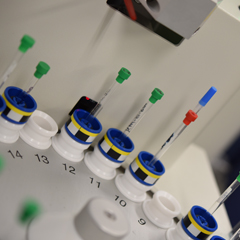
Josua Markus specialises in synthesis, characterization, and applications of plasmonic nanomaterials as therapeutic and diagnostic agents.
Project: Nanomaterials for the Detection of Small-Molecule Disease Markers
The global aim of this PhD project was to develop injectable and implantable SERS nanosensors that could selectively and sensitively detect trace amounts of disease markers. Different diseases are usually characterized by abnormal production of biochemical species, which can then be used as chemical markers for screening method. The sensors would be composed of gold nanoparticles, with molecular probes that serve as receptors and Raman spectroscopy as sensing modality and transducer, to serve as subcutaneous diagnostic agents. The desired nanoscale morphology of gold nanoparticle constructs would be achieved by smart polymer glues. Finally, the nanosensors would be embedded in a thermoresponsive hydrogel as injectable and implantable in vivo SERS sensors for real-time and non-destructive observations.
Josua Markus has accumulated international research experience in Canada, South Korea, and Australia. He has published 20 peer-reviewed articles in SCI/E journals. Currently, he is completing his PhD thesis on the design of SERS chemosensors composed of gold nano-assemblies for the detection of disease markers at the AIBN, within The University of Queensland, and has secured a postdoctoral fellowship in te Whittaker Group. During his tenure as a Master's student, he was employed as a researcher at Hanbang Bio Lab, focusing in designing drug delivery system by polymer-inorganic hybrid nanomaterials. Prior to obtaining MSc, Josua Markus graduated on Dean’s Honours List with distinction from Chemical Engineering and Management Sciences Option from University of Waterloo. He had accumulated 2 years of co-operative work experiences in plant manufacturing and engineering consulting from Hatch Ltd., EcoSynthetix Inc., and Howe Sound Pulp and Paper during his academic years in Canada.
Key Publications
Markus, J, et al. Synthesis of hyaluronic acid or O-carboxymethyl chitosan-stabilized ZnO-ginsenoside Rh2 nanocomposites incorporated with aqueous leaf extract of Dendropanax morbifera Léveille; in vitro studies as potential sunscreen agents. Published. May 2019;43:9188-9200. New Journal of Chemistry .
Seo, KH† and Markus, J†, et al. Facile and green synthesis of zinc oxide particles by Stevia rebaudiana and its in vitro photocatalytic activity. Published. April 2019; doi; 10.1080/24701556.2019.1580291. Inorganic and Nano-Metal Chemistry. † equal contribution
Markus, J†, et al. Biosynthesis, characterization, and bioactivities evaluation of silver and gold nanoparticles mediated by the roots of Chinese herbal Angelica pubescens Maxim. Published. January 2017;12(1):46. Nanoscale Research Letters. † equal contribution
Markus, J, et al. Intracellular synthesis of gold nanoparticles with antioxidant activity by probiotic Lactobacillus kimchicus DCY51T isolated from Korean kimchi. Published. December 2016;95:85-93. Enzyme and Microbial Technology.
Kim YJ, Perumalsamy H, Markus J, Balusamy SR, Wang C, Kang SH, Lee S, Park SY, Kim S, Castro-Aceituno V, Kim SH, Yang DC. Development of Lactobacillus kimchicus DCY51T–mediated gold nanoparticles for delivery of ginsenoside compound K: in vitro photothermal effects and apoptosis detection in cancer cells. Published. January 2019;47(1):30-44. Artificial Cells, Nanomedicine, and Biotechnology.

